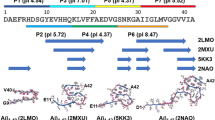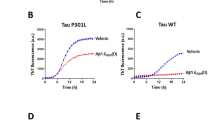Abstract
Inhibition of cerebral amyloid β-protein deposition seems to be an important target for Alzheimer's disease therapy. Amyloidogenesis could be inhibited by short synthetic peptides designed as β-sheet breakers. Here we demonstrate a 5-residue peptide that inhibits amyloid βprotein fibrillogenesis, disassembles preformed fibrils in vitro and prevents neuronal death induced by fibrils in cell culture. In addition, the β-sheet breaker peptide significantly reduces amyloid βprotein deposition in vivo and completely blocks the formation of amyloid fibrils in a rat brain model of amyloidosis. These findings may provide the basis for a new therapeutic approach to prevent amyloidosis in Alzheimer's disease.
This is a preview of subscription content, access via your institution
Access options
Subscribe to this journal
Receive 12 print issues and online access
$209.00 per year
only $17.42 per issue
Buy this article
- Purchase on Springer Link
- Instant access to full article PDF
Prices may be subject to local taxes which are calculated during checkout
Similar content being viewed by others
References
Soto, C., Branes, M.C., Alvarez, J. & Inestrosa, N.C. Structural determinants of the Alzheimer's amyloid beta-peptide. J Neurochem. 63, 1191–1198 (1994).
Pike, C.J., Burdick, D., Walencewicz, A.J., Glabe, C.G. & Cotman, C.W. Neurodegeneration induced by beta-amyloid peptides in vitro: the role of peptide assembly state J. Neurosci. 13, 1676–1687 (1993).
Lorenzo, A. & Yankner, B.A. Beta-amyloid neurotoxicity requires fibril formation and is inhibited by congo red. Proc. Natl. Acad. Sci. USA. 91, 12243–12247 (1994).
Yankner, B.A. Mechanisms of neuronal degeneration in Alzheimer's disease. Neuron. 16, 921–932 (1996).
Soto, C., Kindy, M.S., Baumann, M. & Frangione, B. Inhibition of Alzheimer's amyloidosis by peptides that prevent β-sheet conformation. Biochem. Biophys. Res. Commun. 226, 672–680 (1996).
Soto, C., Castaño, E.M., Frangione, B. & Inestrosa, N.C. The alpha-helical to beta-strand transition in the amino-terminal fragment of the amyloid beta-peptide modulates amyloid formation. J. Biol. Chem. 270, 3063–3067 (1995).
Hilsich, C., Kisters-Woike, B., Reed, J., Masters, C.L. & Beyreuther, K. Substitutions of hydrophobic amino acids reduce the amyloidogenicity of Alzheimer's disease βA4 peptides. J. Mol. Biol. 228, 460–473 (1992).
Lee, J.P. et al. H-1 NMR of A-beta amyloid peptide congeners in water solution. Conformational changes correlate with plaque competence. Biochemistry 34, 5191–5200 (1995).
Wood, J.D., Wetzel, R., Martin, J.D. & Hurle, M.R. Prolines and amyloidogenicity in fragments of the Alzheimer's peptide /A4. Biochemistry 34, 724–730 (1995).
Chou, P.Y. & Fasman, G.D. Empirical predictions of protein conformation. Ann. Rev. Biochem. 47, 251–276 (1978).
Soto, C., Castaño, E.M., Prelli, F., Kumar, R.A. & Baumann, M. Apolipoprotein E increases the fibrillogenic potential of synthetic peptides derived from Alzheimer's, gelsolin and AA amyloids. FEBS Letters 371, 110–114 (1995).
Wood, S.J., Maleeff, B., Hart, T. & Wetzel, R. Physical, morphological and functional differences between pH 5.8 and 7.4 aggregates of the Alzheimer's amyloid peptide AP. J. Mol. Biol. 256, 870–877 (1996).
Simmons, L.K. et al. Secondary structure of amyloid beta peptide correlates with neurotoxic activity in vitro. Mol. Pharmacol. 45, 373–379 (1994).
Sigurdsson, E.M., Lorens, S.A., Hejna, M.J., Dong, X.W. & Lee, J.M. Local and distant histopathological effects of unilateral amyloid- 25–35 injections into the amygdala of young F344 rats. Neurobiol. Aging. 17, 893–901 (1996).
Sigurdsson, E.M., Lee, J.M., Dong, X.W., Hejna, M.J. & Lorens, S.A. Bilateral injections of Amyloid-β 25–35 into the amygdala of young fischer rats: Behavioral, neurochemical and time dependent histopathological effects. Neurobiol. Aging 18, 591–608 (1997).
Arriagada, P.V., Growdon, J.H., Hedley-Whyte, E.T. & Hyman, B.T. Neurofibrillary tangles but not senile plaques parallel duration and severity of Alzheimer's disease. Neurology 42, 631–639 (1992).
Jimenez-Huete, A. et al. Antibodies directed to the carboxyl terminus of amyloid beta peptide recognize sequence epitopes and distinct immunoreactive deposits in Alzheimer's disease brain. Alzheimer's Report 1, 1–7 (1998).
Games, D. et al. Alzheimer-type neuropathology in transgenic mice overexpressing V717F -amyloid precursor protein. Nature 373, 523–527 (1995).
Hsiao, K.K. et al. Correlative memory deficits, A elevation, and amyloid plaques in transgenic mice. Science 274, 99–102 (1996).
Holcomb, L. et al. Accelerated Alzheimer-type phenotype in transgenic mice carrying both mutant amyloid precursor protein and presenilin 1 transgenes. Nature Med. 4, 97–100 (1998).
Glenner, G.G. Amyloid deposits and amyloidosis. The β-fibrilloses. N. Engl. J. Med. 302, 1283–1292 (1980).
Lorenzo, A., Razzaboni, B., Weir, G.C. & Yankner, B.A. Pancreatic islet cell toxicity of amylin associated with type-2 diabetes mellitus. Nature 368, 756–760 (1994).
Forloni, G. et al. Neurotoxicity of a prion protein fragment. Nature 362, 543–546 (1993).
Esler, W.P. et al. Aβ deposition inhibitor screen using synthetic amyloid. Nature Biotechnol. 15, 258–263 (1997).
Wisniewski, T., Ghiso, J. & Frangione, B. Alzheimer's disease and soluble Aβ. Neurobiol. Aging. 15, 143–152 (1994).
Thomas, P.J., Qu, B. & Pedersen, P.L. Defective protein folding as a basis of human disease. Trends Biochem. Sci. 20, 456–459 (1995).
Kelly, J.W. Alternative conformations of amyloidogenic proteins govern their behavior. Curr. Opin. Struct. Biol. 6, 11–17 (1996).
Soto, C. et al. Reversal of disease-specific prion protein conformation and protease-resistance by peptides designed as β-sheet breakers. (Manuscript submitted).
Janossy, G., Greaves, M.F., Doenhoff, M.J. & Snajder, J. Lymphocyte activation. Quantitation of the proliferative response to mitogens using defined T and B cell populations. Clin. Exp. Immunol. 14, 581 (1973).
Duke, CR, et al. in Current Protocols in Immunology (eds. Coligan, J.E., Kruisbeek, A.M., Margulies, D.H., Shevach, E.M., and Strober, W) 17.1–17.33 (John Wiley & Sons, New York, 1995).
Author information
Authors and Affiliations
Rights and permissions
About this article
Cite this article
Soto, C., Sigurdsson, E., Morelli, L. et al. β-sheet breaker peptides inhibit fibrillogenesis in a rat brain model of amyloidosis: Implications for Alzheimer's therapy. Nat Med 4, 822–826 (1998). https://doi.org/10.1038/nm0798-822
Received:
Accepted:
Issue Date:
DOI: https://doi.org/10.1038/nm0798-822
This article is cited by
-
Endothelial leakiness elicited by amyloid protein aggregation
Nature Communications (2024)
-
Nanocomposites Facilitate the Removal of Aβ Fibrils for Neuroprotection
Chemical Research in Chinese Universities (2022)
-
Destabilization of the Alzheimer’s amyloid-β peptide by a proline-rich β-sheet breaker peptide: a molecular dynamics simulation study
Journal of Molecular Modeling (2021)
-
Polymer materials as promoters/inhibitors of amyloid fibril formation
Colloid and Polymer Science (2021)
-
Chiral gold nanoparticles enantioselectively rescue memory deficits in a mouse model of Alzheimer’s disease
Nature Communications (2020)



